It has been a great experience writing about Bidar, which I think am the only person in recent times to have written extensively. Even though tracing down the Bahmani kingdom through its inception in Gulbarga to its final days in Bidar was tedious, I feel extremely happy and honored to introduce the last living descendants.
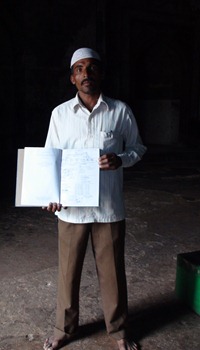 As you visit the Tomb of Ahmed Shah Wali Bahmani, you will find a simple looking man sitting guard inside. There is no such arrangement for the others. They are either locked or left open. I started talking to the person about the time and ages of the construction and I was taken aback. However, the pitiable conditions under which he is living, but he is still “His Royal Highness, Sultan Khaleel Shah Bahmani”, of the 12th generation.
As you visit the Tomb of Ahmed Shah Wali Bahmani, you will find a simple looking man sitting guard inside. There is no such arrangement for the others. They are either locked or left open. I started talking to the person about the time and ages of the construction and I was taken aback. However, the pitiable conditions under which he is living, but he is still “His Royal Highness, Sultan Khaleel Shah Bahmani”, of the 12th generation.
I was awestruck knowing this. I am face to face with a descendent of one of the most famous dynasties of the Deccan. I started talking to him more and he offered to take me to his house. Behind the tombs is a narrow muddy road which leads to a  small village. Looking at his home, I wondered what Ahmed Shah Wali could have thought seeing the member of his family staying at such a pitiable place. It is a small four room brick building with tiled roof.
small village. Looking at his home, I wondered what Ahmed Shah Wali could have thought seeing the member of his family staying at such a pitiable place. It is a small four room brick building with tiled roof.
“Everything has gone away with time” he sadly noted. The house he is living was given by the government after his family was evicted from the tomb premises. His family consists of his wife, four daughters and a son. In all these years he gathered information about his ancestors and can recognize them through paintings. He has also preserved a few coins minted by his ancestor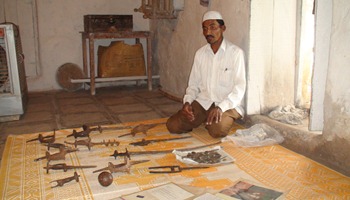 s. He has a good collection of armory like swords and daggers. He is not the only one of the dynasty. His brothers visit the place some times and they too are in the same economically backward condition, he said. He had refused to return the armory and coins to ASI fearing that his identity with the dynasty will be lost forever.
s. He has a good collection of armory like swords and daggers. He is not the only one of the dynasty. His brothers visit the place some times and they too are in the same economically backward condition, he said. He had refused to return the armory and coins to ASI fearing that his identity with the dynasty will be lost forever.
With the Bahmani dynasty introduced, I bid good bye to the land of Bidar and move on.
The name Takth Mahal is modern, for it is not mentioned in contemporary history, although the magnificence of the royal palace built by Ahmed-Shah-Wali at Bidar is extolled by Sayyid Ali Tabataba in his work entitled, Burhan-i-Maathir. The author mentions a palace and a forecourt but does not mention the name of the palace. It may be interesting to quote that this book gives certain features of the building, such as its arches and towers, and its blue tiles. The name Takth Mahal was apparently given by the literati of Bidar who had read accounts of Ferishta, who did not find a more appropriate edifice among the ruins of the Bahmani buildings which could be associated with the throne. The audience hall where the throne was actually placed did not meet the descriptions written by the above mentioned writers. The plan of the so-called Takth Mahal, however, agrees to them, and should not be confused with the Public Audience hall.
I cannot write much about this place owing to the fact that I am doubtful about the authenticity of the photographs I had taken. I am not sure if they belong to the Takth Mahal. However, I will end with a description of the throne. This throne was gifted to Sultan Tughlak Shah by Telinga (Andhra Kings) ambassadors as part of a peace treaty. Ferishta quotes eye witnesses that the throne was nine feet long and three feet broad. It was made of ebony covered with plates of pure gold, and set with precious stones of immense value. The throne had the flexibility of jewels being added and replaced. It became a custom that every prince had put their own mark of jewelry on the throne. During the reign of Sultan Muhammad Shah, it was valued at three and a half crores of rupees. This splendid throne was called the Firozah, owing, as Ferishta says, to it being partly enameled of a sky blue color was which in time was entirely concealed by the number of jewels.
This throne was was originally setup in the Durbar hall of Gulbarga was later moved to Bidar and put in the audience hall.
We have come to the end of our marvelous and memorable journey across the Bahmani Kingdom. I will end this series with an interesting account of a meeting… Watch out….
This is by far the most difficult post to write as it took one long month for me to gather information. The place is in ruins and it is very difficult to identify easily. However, referring to my pictures and the content that I studied, we could relate. This building was also called the Jali Mahal on account of some screens of trellis work which were visible in the early 19th century. Unfortunately, you cannot find trace of them today. The Archeological Department of Hyderabad conducted extensive excavations then and it has disclosed not only the plan of the building but also the architectural and decorative features. Most of the decorative stuff has been removed and stored in museums.
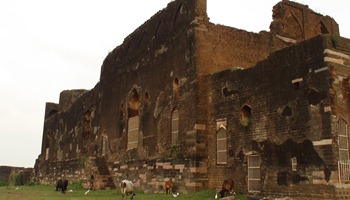 This building is situated to the west of the Zanana enclosure and is approached by a road which proceeds from the former. The outer wall of the Diwani-i-Am is preserved up to a considerable height on the southern side but it raises only to a few feet on the other three sides. It has two entrances to east and west but they do not face each other. The earlier excavations have exposed the original pavement of the eastern entrance, but the masonry of its outer and inner gateways, which must have comprised large blocks of carved stones, has all disappeared.
This building is situated to the west of the Zanana enclosure and is approached by a road which proceeds from the former. The outer wall of the Diwani-i-Am is preserved up to a considerable height on the southern side but it raises only to a few feet on the other three sides. It has two entrances to east and west but they do not face each other. The earlier excavations have exposed the original pavement of the eastern entrance, but the masonry of its outer and inner gateways, which must have comprised large blocks of carved stones, has all disappeared.
Passing through the entrance, we approach the court of the building which measures 166x133 feet in dimensions. The l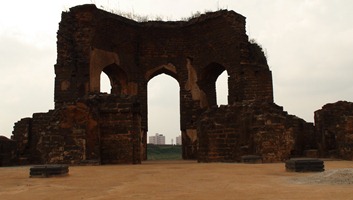 atter is divided into two parts. The principal hall of the building, which was probably used for public audiences is on the southern side and is approached by five steps from the pavement. The hall is divided into three apartments by rows of pillars, six in each row. The total length of the hall is 109 feet. These pillars of the hall were probably of wood, and they have all perished. The stone pedestals on which the wooden shafts rested are, however intact. The walls of the hall were originally decorated with panels of tile-work, some of them which have survived and currently being restored in museums. The colors of these tiles faded, for the tiles have reminded buried in debris for a number of years. It is said that two of these tiles were moved to a mosque in Bidar initially and later to a museum in Britain.
atter is divided into two parts. The principal hall of the building, which was probably used for public audiences is on the southern side and is approached by five steps from the pavement. The hall is divided into three apartments by rows of pillars, six in each row. The total length of the hall is 109 feet. These pillars of the hall were probably of wood, and they have all perished. The stone pedestals on which the wooden shafts rested are, however intact. The walls of the hall were originally decorated with panels of tile-work, some of them which have survived and currently being restored in museums. The colors of these tiles faded, for the tiles have reminded buried in debris for a number of years. It is said that two of these tiles were moved to a mosque in Bidar initially and later to a museum in Britain.
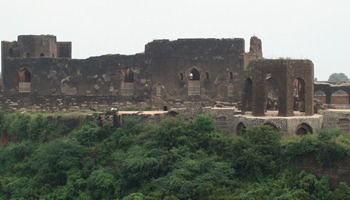 One of the panels had a calligraphic text in the form of Swastika containing the name of “Ali”, the son in law of Prophet Mohammed, repeated four times in the Kufic script. These tiles were probably made by Persian craftsmen, for artists and technicians of the latter country were much patronized by the Bahmanis. The ceiling of the hall may again have been of wood. In the hall was placed the Takth-i-Firoza, Turquoise throne. At the back of the hall remains of a room may be noticed, the middle one may have been for the King. The floor had mosaic design comprising geometrical patterns such as hexagons and stars. There are two more rooms behind the King’s chamber, probably belonging to the ministers. The remains of walls in the south indicate an upper storey which had an arched screen built along its sides.
One of the panels had a calligraphic text in the form of Swastika containing the name of “Ali”, the son in law of Prophet Mohammed, repeated four times in the Kufic script. These tiles were probably made by Persian craftsmen, for artists and technicians of the latter country were much patronized by the Bahmanis. The ceiling of the hall may again have been of wood. In the hall was placed the Takth-i-Firoza, Turquoise throne. At the back of the hall remains of a room may be noticed, the middle one may have been for the King. The floor had mosaic design comprising geometrical patterns such as hexagons and stars. There are two more rooms behind the King’s chamber, probably belonging to the ministers. The remains of walls in the south indicate an upper storey which had an arched screen built along its sides.
We now visit the Takth Mahal or the Royal Palace.




